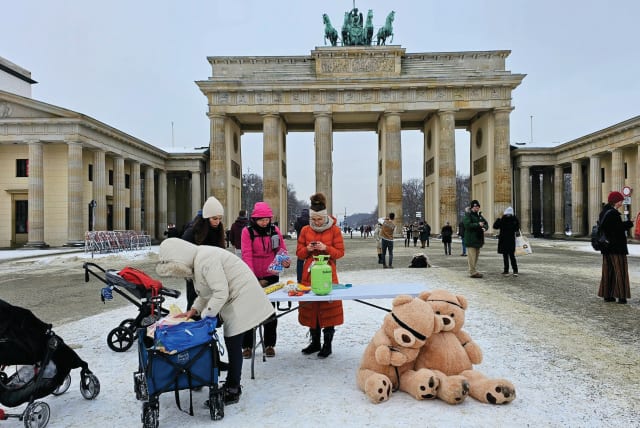Holocaust to Kfir Bibas: A mission to Berlin

Berlin’s commitment to remembering its past and protecting its Jewish community was evidenced throughout this experience.
My initial visit to Berlin, Germany, coincided with the week of International Holocaust Remembrance Day 2024, adding a symbolic layer to my experience. As someone from Israel, this trip held particular significance, allowing me to witness the juxtaposition of Germany’s Nazi history and its contemporary reality.
The comparison between the dark times of 80 years ago and recent days became even more pronounced during my visit, which was specifically planned to mark the first birthday in captivity of Kfir Bibas, who was kidnapped on October 7 with his parents Shirel and Yarden, and his four-year-old brother, Ariel.
The occasion was marked by the Unsilenced Brushes art exhibition, held for one night. The exhibition featured over 40 carefully selected works by artists from Israel and Europe, which included paintings, drawings, sculptures, and folk art. Each piece aimed to shed light on the story of Kfir and his family. By leveraging art as a medium for advocacy, the goal was to bring attention to the tragic story of this kidnapping episode in modern history. Choosing Kfir’s first birthday as the date of the exhibition added a highly symbolic layer to my visit.
The Holocaust history of Berlin
While exploring downtown Berlin, I couldn’t help noticing plaques embedded in snowy sidewalks, marking the memory of those murdered during the Holocaust, a stark reminder of the most horrific war crimes in history against the Jews. This somber memory coexisted with new, fashionable clothing stores, emphasizing the city’s complex historical and modern identity.
The day of the art exhibition, I set out to explore the city on foot, making my way through the snow toward Brandenburger Tor (Brandenburg Gate), aka Victory Gate. The monument, steeped in historical significance, has been witness to numerous pivotal events throughout time. Today, it is not only a symbol of Germany and Europe’s tumultuous past but also embodies the ideals of European unity and peace. During the Nazi regime, the gate served as a party symbol, yet remarkably it survived the ravages of World War II.
In recent years, a powerful image has circulated, illustrating the duality of the gate’s history. On one side, it is adorned with the symbol of the Nazi party, reflecting its dark past. On the other side, it is painted in the colors of blue and white, featuring the Star of David – a poignant gesture symbolizing identification with the State of Israel. This visual contrast encapsulates the gate’s journey from a symbol of division to a representation of unity and solidarity.
En route to Brandenburg Gate, I passed the Reichstag building, a historically significance structure that served as the legislature of the German Empire, the Weimar Republic, and Nazi Germany. The juxtaposition of this building with the nearby Paul Löbe Haus, a modern architectural marvel, symbolizes the synergy between Berlin’s modern political landscape and its historical roots.
Before reaching Brandenburg Gate, I encountered the Holocaust Memorial, which opened to the public in 2005 and features 2,711 concrete slabs inscribed with the names of approximately three million Holocaust victims. Against the backdrop of this solemn memorial, the Berlin Television Tower – a futuristic marvel – stands as a symbol of resilience and unity for the city.
Upon reaching the monument, I serendipitously observed a woman pushing a baby carriage with huge teddy bears – a poignant reminder of my mission to commemorate Kfir Bibas’s first birthday. I immediately pulled out my camera to capture this symbolic moment against the backdrop of the gate. Engaging with the woman, an Israeli living in Berlin, I learned about a rally being organized to mark the first birthday of Kfir, the youngest Israeli hostage in Gaza. The rally was expected to attract more people with baby carriages and orange balloons symbolizing the color of the children’s red hair.
The proximity of the Holocaust Memorial representing the horrors of the past and the rally calling for the release of the kidnapped was emotionally charged and symbolically rich. Remaining in place, I offered my assistance in organizing the rally. Just then Sasha Roytman, the CEO of the Combat Antisemitism Movement (CAM) and our partner in the art exhibition, who had flown in from Israel and rented a car, came to Brandenburg Gate. Our exploration of the city by car included landmarks such as the Berlin Wall and its remains, showcasing the solidarity expressed by German institutions toward Israel. The sight of the flags of Israel, Ukraine, and Germany waving side by side symbolized a strong message of unity.
Berlin’s commitment to remembering its past and protecting its Jewish community was evidenced throughout this experience. The municipality’s dedication to honoring the memory of the Holocaust – while actively supporting the release of all hostages held in Gaza– is admirable and inspiring. ■
The writer is ISRAEL-is foreign affairs manager.
Jerusalem Post Store
`; document.getElementById("linkPremium").innerHTML = cont; var divWithLink = document.getElementById("premium-link"); if (divWithLink !== null && divWithLink !== 'undefined') { divWithLink.style.border = "solid 1px #cb0f3e"; divWithLink.style.textAlign = "center"; divWithLink.style.marginBottom = "15px"; divWithLink.style.marginTop = "15px"; divWithLink.style.width = "100%"; divWithLink.style.backgroundColor = "#122952"; divWithLink.style.color = "#ffffff"; divWithLink.style.lineHeight = "1.5"; } } (function (v, i) { });

